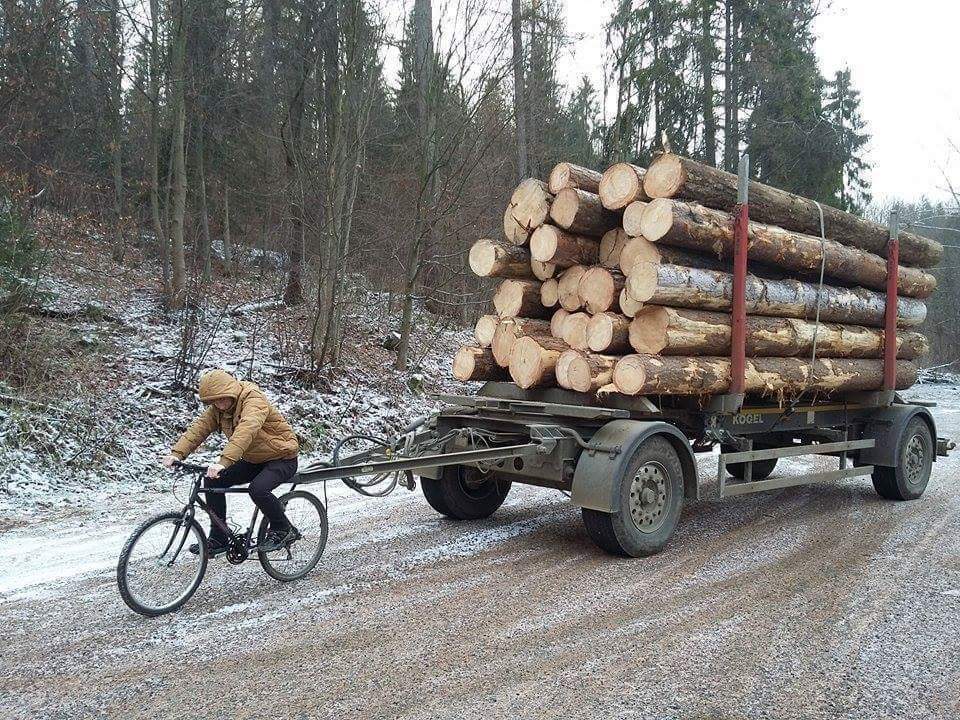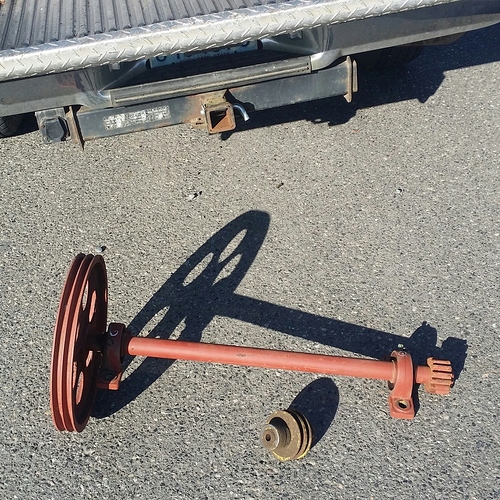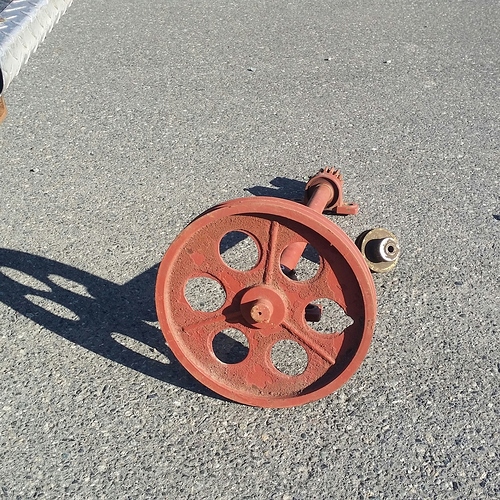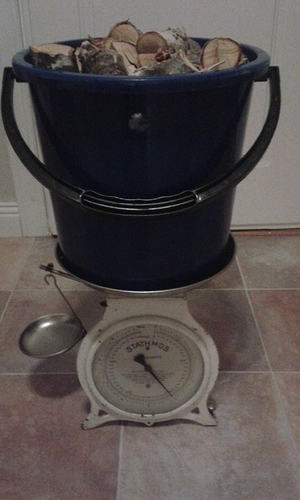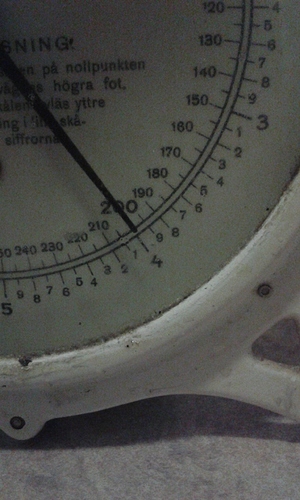That hatchet idea has it’s limitations; http://articles.sun-sentinel.com/1997-12-27/lifestyle/9712240248_1_tennis-elbow-forearm-muscles-sore-elbow
Bob Mackey has been burning all his wood doing testing on the auto mixer 92 dodge
So I found a 14" Jet bandsaw for $100 that had a few issues actually got it for $50 and 100 mile DOW (no cost). The cast pot metal tension and tilt fitting was broken.
I welded up a couple of U bolt fittings and bolted them on to hold the tilt pins and it works just fine
So I am planning another 300 mile trip over the Cascade mountains to deliver it to Bob and get a personal tour and ride in his hot rod Dodge
Wow Michael, that was Quick. Dana and I and some friends went on a hike to the ancient lakes area over by Quincy. Just got back and you have the band saw repaired and running already. Cutting up wood has just become easier. Thank you so very much.
Bob
Thanks Brian .
It seems with many of my daily chores I feel just like this guy on the bike. 
Glade the photo doesn’t show in detail how the air brake hose is connected to him.
Wayne, you make me laugh!
Very funny Wayne…I had to laugh as well…I needed some good humor this mornig…
I found this at the scrap yard yesterday, and I think it will make a nice small chunker for me, similar to @KristijanL 's tractor chunker above (post #664), or @Patrick1 's model.
I left the house in a hurry and wasn’t expecting to be able to get to the scrap yard, so I didn’t grab any measurement devices. I think the axle shaft is about 2" diameter; the double-belted pulley is about 12" diameter. I can measure more accurately after I wake up a bit more.
If I were to bolt this down to a gusseted I-Beam (big grade-8 bolts), what direction would be the strongest/toughest for applying force? I’d guess that pushing down on the base of the bearings; pushing the wide base directly into the I-Beam, without and side-shear would be the strongest/easiest to manage. Am I correct in that? If so, I’d want to put my cutting anvil at the top of my cutter blade.
Great find! I like the long axle, l wish l wuld make a longer one when l was building. It doesent matter for chunks, but it wuld be great for chopping limbs for firewood.
I was afraid the bolts wildnt hold for a sideways force but l tryed it anyways and there is no problem. Keep in mind if the geometry of the blade is correct there is actualy not that much force on it.
If you are still sceptical and want the force to be pressing down on the bearings (to reduce tension on the bolts) and not haveing the anvil on top of the blade, you can always rotate the picture and bolt the bearings vertivaly. Or eaven up side down. Hope l make sence.
Hi Brian
Your idea would probably be the strongest way for the bearings, but I have had no problems with them breaking and used them on a lot of different things. The weakest part is the housing it is cast, the ears will break were the bolt goes through if they are not sitting on a flat surface when bolted down real tight.
Yeah, hanging the setup from the bottom of my I-Beam and setting the anvil on the bottom edge (flipping everything upside-down) makes a lot more sense, and would make using the setup so much easier; the chunks would fall straight ground vs falling on the spinning axle and potentially be flung/hung up.
Measured the axle thingy. The axle is just over 1-5/8ths inch diameter, but that’s with a heavy layer of paint; the ends of the shaft, where the pulley and gear are attached, are almost exactly 1-1/2 inch diameter with a 3/8ths inch wide keyway cut in them; the pulley is 15 inches diameter, but slightly out of balance. Bolt holes for the pillow bearings are slightly under 3/4" by 13/16ths oblong.
Same bucket of chunks as 23 days ago. Spred out on a desk in my heated (15 C or 60 F) garage. No forced air. Weight reduced from 5,6kg to 4,0kg. Weight loss close to 30%.
This was denst birch limb chunks. If I remember I’ll try the same experiment with my bulky alder wood. I bet I’ll get close to 50% weight loss.
Interasting! Wuld you consider those chunks gasifier dry? This is a 12l bucket right? This is about the same bulk density as my beech or polewood.
Do you have black alder up there?
I found a interasting chart on different wood densitys, energy content in corelation to volume and weight for different woods. In much of my surprice, black alder is high on the in energy content. I think first is pine.
Edit: l wanted to post the charts but they are in Slovene 
Anyway, l looked at it agen and it seems takeing all the data (bulk density, energy content) your birch is actualy better for gasification thain my beech! Wuld never have guessed it!
It’s said to grow here but I don’t know if I would recognize black alder if I saw it. It’s called klibbal “sticky alder” here. The one I talked about is gray alder. Grows up here a lot, Finland and Russia. Also western Canada.
Not much difference in species energy content by weight, right? A lot by volume though.
Edit: Yes, birch is super 
Oh, I forgot. Yes, those bucket birch chunks are gasifier dry. I’ve tried green wood in the gasifier too. Couldn’t feel much difference except from getting a lot of hopper juice.
We have only black alder here. The easyest way to tell is it has red wood.
Ha i think l know why its called “sticky”.
Actualy, there is surpriseing difference in energy/mass of woods! Poplar has allmost a third less energy then pine. I think the reason behind this is resins and oils in wood.
Ha! I drowned the engine and smoked thestreet trying greenwood in gasifier 
Great information J.O.
But remember those kilograms of water moisture did not disappear out of your garage. They were from the air transporter absorbed then by all of the other moisture capable sucking materials inside that garage.
Here, why in the already wet airs rain forest, I am always horrified by those who propose to me going back to the old days ways of inside the house lines/rack drying of washed clothing.
Pound and pounds; kilograms and kilograms of introduces moisture leads to black, green unhealthy molds in all papers and fabrics. Red rusting and white spot corrosion of all shop tools and metals.
Drying down for real, contenuos wood fuel use needs moisture removing ventilation.
You and I space heat with wood and know well that a large function to the flue draft is to sweep up, out, and away, excessive fuel wood moisture.
Regards
Steve Unruh
Yeah, very true. Nothing ever disappears.
Lots of people are easily led to belive things disappear when they change location. Just think about all the junk that is produced. Easy to get rid of when no longer wanted, to clean up and “throw away”. To were? Very few people think about it.
Very true on ventilation as well. No ventilation, no getting rid of moisture.
About indoors humidity.
We actually have the opposite problem during winter. Low outside temps shrinking the air making it unable to carry much moisture. Instead ice crystals form, robbing the air of its moisture. Indoors heating expands the already dry air and humidity drops to dry skin and cracked lips levels.
Edit: I remember my grandma always froze dried washed clothing on lines up in the the attic. Moisture dissapeared 
True. In the winter we usualy have a tray of water on our wood burning stove, boiling and steaming. Otherwise we all have skin and respiratory problems.
We sometimes put orange peel in the water tray. Or a drop of essencial oil. Makes s nice smell
Kristijan, I’ve never been in your neighbourhood in wintertime. I always thought you, living south of the Alps, had Mediterranean climate???
